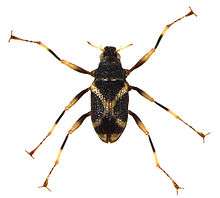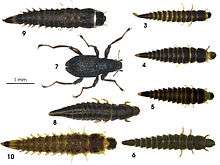Ancyronyx
| Spider water beetles | |
|---|---|
 | |
| Ancyronyx schillhammeri adult | |
 | |
| Ancyronyx patrolus larva | |
| Scientific classification | |
| Kingdom: | Animalia |
| Phylum: | Arthropoda |
| Class: | Insecta |
| Order: | Coleoptera |
| Suborder: | Polyphaga |
| Family: | Elmidae |
| Subfamily: | Elminae |
| Tribe: | Ancyronychini Ganglbauer, 1904 |
| Genus: | Ancyronyx Erichson, 1847 |
| Type species | |
| Macronychus variegatus Germar, 1824 | |
| Species | |
|
See text | |
Ancyronyx, commonly known as spider water beetles or spider riffle beetles, is a genus of aquatic riffle beetles from North America, South Asia, China, and Southeast Asia. They are small beetles with extremely long legs ending in strong claws. Both the adults and the larvae are found underwater in the shallow riffles of streams and rivers, clinging to rocks or submerged wood. They feed on algae and decaying wood tissue. The genus contains twenty-one species, eleven of which are endemic to the Philippines.
Taxonomy
The genus Ancyronyx was established in 1847 by the German entomologist Wilhelm Ferdinand Erichson based on the type species Macronychus variegatus first described in 1824 by the German coleopterologist Ernst Friedrich Germar.[1] It was regarded as a monotypic species until the French entomologist Antoine Henri Grouvelle described the second species, A. acaroides in 1896.[2][3] It is the sole member of the tribe Ancyronychini, and is classified under the subfamily Elminae of the riffle beetle family, Elmidae.[3]
Description
Members of Ancyronyx superficially resemble spiders and are aquatic, hence their common name, "spider water beetles". They are typically very small, with an average body length (without legs) of 1 to 2 mm (0.039 to 0.079 in). They are characterized by extremely long legs (longer than the body length).[4] The legs have widely separated coxae, with the procoxae (coxae attached to the prothorax) usually visible dorsally. The legs are tipped with large claws, each with two or three basal teeth. The distal teeth are the largest.[5] The pair of antennae are typically 11-segmented.[6] Most of the species possess brightly colored patterns on their elytra, but not all.[2][5][7] The elytra also possess eight to eleven grooves (elytral striae), as well as small depressions (elytral punctures) of varying depth and number. The pronotum possesses a transverse groove and a more or less straight front margin, with pronotal carinae absent or weakly present.[5]
Spider water beetles can be divided into two species groups, based on morphological and ecological adaptation patterns.[8]
- The Ancyronyx variegatus species group are larger in size (usually larger than 1.4 mm (0.055 in)), with very long legs, stout coxites on the ovipositor, and a transverse prosternal process. Their larvae are also larger, depressed in cross-section, and possess large side-pointing projections on the sides of the abdomen.[3][5][8]
- The Ancyronyx patrolus species group have small and slender bodies, with comparatively shorter legs, long and slender coxites on the ovipositor, and a squarish prosternal process. Their larvae are smaller, with a more vaulted cross-section, and backwards pointing projections from the sides of the abdomen.[3][5][8]
Ancyronyx is closely related to the genus Podelmis, but can be distinguished from the latter by the more or less straight and slender last segment of the ovipositor (versus the conical sideways-bent terminal segment of the ovipositor of Podelmis), and the absence of an anterior process on the prosternum.[3]
Ecology

Like almost all riffle beetles, spider water beetles are aquatic, feeding on algae and decaying wood tissue.[5][9] However, they can not actively swim.[10] They can be found crawling along or clinging with their claws on boulders or submerged wood in lotic riffles of streams and rivers.[2]
The larvae are exclusively aquatic. They breathe by means of tracheal gills. Spider water beetle adults, like all members of the subfamily Elminae, can also remain indefinitely underwater by means of a plastron, a thin film of gas trapped by hydrophobic bristles (setae) on their body. As the insect breathes, the oxygen concentration in the gas film drops in comparison to the surrounding water, causing new oxygen to diffuse again into the plastron.[10][11][12]
Because of their reliance on the plastron for breathing, spider water beetles are restricted to the highly oxygenated environments in moderate to fast-moving permanent running water.[5] They are therefore extremely sensitive to water pollution and are potentially valuable bioindicators for measuring the health of river ecosystems.[4][13]
Members of the Ancyronyx variegatus species group are mostly found in slightly to moderately polluted (mesosaprobic) rivers, almost always found on submerged wood (with the exception of Ancyronyx yunju which were collected from sand and grass roots). Members of the Ancyronyx patrolus species group, meanwhile, are only found in clean permanent streams, usually among rocks.[3][5][8]
Ancyronyx malickyi have been caught using light traps, which might indicate phototaxis.[2]
Distribution
The genus was previously only known from two species from highly disjunct localities – Ancyronyx variegatus from North America (described in 1824) and Ancyronyx acaroides from Palembang in Sumatra (described in 1896). This strange distribution pattern (and the fact that there were no new specimens of A. acaroides recovered) initially led 20th century specialists to question whether A. acaroides was indeed collected from Sumatra, or whether it was correctly designated to the genus as originally described. However, in 1991, new specimens of A. acaroides were rediscovered from Sumatra by the Austrian coleopterologists Manfred A. Jäch and S. Schödl, confirming its type locality. In addition they also discovered the species in Southeast Asia, including West Malaysia, Sarawak and Bali during 1992 and 1993. The species was also subsequently found in Thailand, Indonesia and the Philippines.[2] Since then, nineteen new species of the genus have been described from Southeast Asia and China.[3][5][14][15]
Species


There are twenty-one species currently classified under Ancyronyx.[11][16] Eleven of these are endemic to the Philippines, which may indicate that the country is a center of diversity for the genus.[7][12] Most of the species have highly restricted distributions, often being found in only one island.[16][17]
- Ancyronyx acaroides Grouvelle, 1896 – Southeast Asia
- Ancyronyx buhid Freitag, 2013 – Philippines (Mindoro)
- Ancyronyx helgeschneideri Freitag & Jäch, 2007 – Philippines (Palawan, Busuanga)
- Ancyronyx hjarnei Jäch, 2003 – Indonesia (Sulawesi)
- Ancyronyx jaechi Freitag, 2012 – Sri Lanka
- Ancyronyx johanni Jäch, 1994 – Indonesia (Siberut)
- Ancyronyx malickyi Jäch, 1994 – Laos, southern Thailand, Malaysia (peninsular Malaysia, Borneo), Indonesia (Sumatra)
- Ancyronyx minerva Freitag & Jäch, 2007 – Philippines (Palawan, Busuanga, Mindoro)
- Ancyronyx minutulus Freitag & Jäch, 2007 – Philippines (Palawan)
- Ancyronyx montanus Freitag & Balke, 2011 – Philippines (Palawan)
- Ancyronyx patrolus Freitag & Jäch, 2007 – Philippines (Palawan, Busuanga)
- Ancyronyx procerus Jäch, 1994 – Vietnam, Malaysia (Borneo), Brunei, Philippines (Busuanga)
- Ancyronyx pseudopatrolus Freitag & Jäch, 2007 – Philippines (Palawan)
- Ancyronyx punkti Freitag & Jäch, 2007 – Philippines (Palawan)
- Ancyronyx raffaelacatharina Jäch, 2004 – Indonesia (Sulawesi)
- Ancyronyx sarawacensis Jäch, 1994 – Malaysia (Borneo)
- Ancyronyx schillhammeri Jäch, 1994 – Philippines (Mindoro)
- Ancyronyx sophiemarie Jäch, 2004 – Philippines (Sibuyan)
- Ancyronyx tamaraw Freitag, 2013 – Philippines (Mindoro)
- Ancyronyx variegatus (Germar, 1824) – United States of America
- Ancyronyx yunju Bian, Guo, & Ji, 2012 – China (Jiangxi)
References
- ↑ Harley P. Brown (1983). A Catalog of the Coleoptera of America North of Mexico, Family: Elmidae (PDF). Agriculture Handbook Number 529-50. Agricultural Research Service, United States Department of Agriculture. p. 3.
- 1 2 3 4 5 Manfred A. Jäch (1994). "A taxonomic review of the Oriental species of the genus Ancyronyx Erichson, 1847 (Coleoptera, Elmidae)". Revue Suisse de Zoologie. 101 (3): 601–622.
- 1 2 3 4 5 6 7 Hendrik Freitag (2013). "Ancyronyx Erichson, 1847 (Coleoptera, Elmidae) from Mindoro, Philippines, with description of the larvae and two new species using DNA sequences for the assignment of the developmental stages". ZooKeys. 321 (321): 35–64. doi:10.3897/zookeys.321.5395. PMC 3744145
 . PMID 23950689.
. PMID 23950689. - 1 2 Hendrik Freitag; Michael Balke (2011). "Larvae and a new species of Ancyronyx Erichson, 1847 (Insecta, Coleoptera, Elmidae) from Palawan, Philippines, using DNA sequences for the assignment of the developmental stages". ZooKeys. 136 (136): 47–82. doi:10.3897/zookeys.136.1914. PMC 3229288
 . PMID 22140348.
. PMID 22140348. - 1 2 3 4 5 6 7 8 9 Hendrik Freitag (2012). "Ancyronyx jaechi sp.n. from Sri Lanka, the first record of the genus Ancyronyx Erichson, 1847 (Insecta: Coleoptera: Elmidae) from the Indian Subcontinent and a world checklist of species". Zootaxa. 3382: 59–65.
- ↑ Ross H. Arnett, JR, Michael C. Thomas, Paul E. Skelley, J. Howard Frank (2002). American Beetles: Polyphaga: Scarabaeoidea through Curculionoidea, Volume 2. CRC Press. p. 118. ISBN 9781420041231.
- 1 2 Pensoft Publishers (October 18, 2011). "Unknown Species And Larval Stages of Extremely Long-legged Beetles Discovered by DNA Test". ScienceNewsline. Retrieved August 21, 2013.
- 1 2 3 4 Hendrik Freitag; Manfred A. Jäch (2007). "The genus Ancyronyx Erichson, 1847 (Coleoptera, Elmidae) in Palawan and Busuanga, (Philippines) with descriptions of six new species". Zootaxa. 1590: 37–59. biostor
- ↑ Arthur C. Benke; Thomas C. Van Arsdall, Jr.; David M. Gillespie; Fred K. Parrish (1984). "Invertebrate productivity in a subtropical blackwater river: the importance of habitat and life history" (PDF). Ecological Monographs. 54 (1): 25–63. doi:10.2307/1942455.
- 1 2 "Elmidae". Identification and Ecology of Australian Freshwater Invertebrates, Murray Darling Freshwater Research Centre. Retrieved August 22, 2013.
- 1 2 Pensoft Publishers (August 6, 2013). "'Beetle in Spider's Clothing' – Quaint New Species from Philippine Rainforest Creeks". ScienceNewsline. Retrieved August 21, 2013.
- 1 2 "Unknown species and larval stages of extremely long-legged beetles discovered by DNA test". Science Codex. October 18, 2011. Retrieved August 22, 2013.
- ↑ K.D. Suarez (August 7, 2013). "New beetle species discovered in Mindoro". Rappler. Retrieved August 21, 2013.
- ↑ Dongju Bian; Cheng Guo; Lanzhu Ji (2012). "First record of Ancyronyx Erichson (Coleoptera: Elmidae) from China, with description of a new species" (PDF). Zootaxa. 3255: 57–61.
- ↑ Gilliann S. Ebreo (November 27, 2012). "Ateneo prof discovers new beetle species". The GUIDON, Ateneo de Manila University. Retrieved August 22, 2013.
- 1 2 Manfred A. Jäch; Ján Kodada (2010). "Family Elmidae". In Joel Hallan. Synopsis of the described Coleoptera of the World.
- ↑ Manfred A. Jäch (2004). "Descriptions of two new species of Ancyronyx Erichson (Insecta: Coleoptera: Elmidae)" (PDF). Annalen des Naturhistorischen Museums in Wien. 105 B: 389–395.
External links
- Description at SringerImages
- Classification at Animal Diversity Web
- Discover Life
- Taxonomic profile of Ancyronyx variegatus at ITIS Report
- Taxonomy at BioLib
- Taxonomy at the Taxonomicon
- Information at Bug Guide
- Encyclopedia of Life